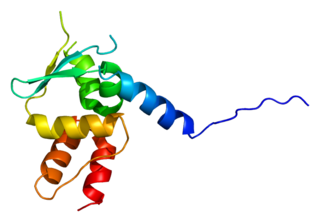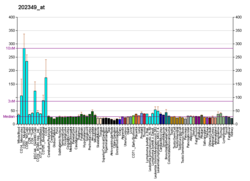Torsion dystonia, also known as dystonia musculorum deformans, is a disease characterized by painful muscle contractions resulting in uncontrollable distortions. This specific type of dystonia is frequently found in children, with symptoms starting around the ages of 11 or 12. It commonly begins with contractions in one general area such as an arm or a leg that continue to progress throughout the rest of the body. It takes roughly 5 years for the symptoms to completely progress to a debilitating state.

Proteolipid protein 1 (PLP1) is a form of myelin proteolipid protein (PLP). Mutations in PLP1 are associated with Pelizaeus–Merzbacher disease. It is a 4 transmembrane domain protein which is proposed to bind other copies of itself on the extracellular side of the membrane. In a myelin sheath, as the layers of myelin wraps come together, PLP will bind itself and tightly hold the cellular membranes together.

Cathepsin A is an enzyme that is classified both as a cathepsin and a carboxypeptidase. In humans, it is encoded by the CTSA gene.

Fukutin is a eukaryotic protein necessary for the maintenance of muscle integrity, cortical histogenesis, and normal ocular development. Mutations in the fukutin gene have been shown to result in Fukuyama congenital muscular dystrophy (FCMD) characterised by brain malformation - one of the most common autosomal-recessive disorders in Japan. In humans this protein is encoded by the FCMD gene, located on chromosome 9q31. Human fukutin exhibits a length of 461 amino acids and a predicted molecular mass of 53.7 kDa.

The human gene SPAST codes for the microtubule-severing protein of the same name, commonly known as spastin.

Aprataxin is a protein that in humans is encoded by the APTX gene.

Epsilon-sarcoglycan is a protein that in humans is encoded by the SGCE gene.

Three prime repair exonuclease 1 is an enzyme that in humans is encoded by the TREX1 gene.

Sodium/potassium-transporting ATPase subunit alpha-3 is an enzyme that in humans is encoded by the ATP1A3 gene.

Lipopolysaccharide-induced tumor necrosis factor-alpha factor is a protein that in humans is encoded by the LITAF gene.

Ganglioside-induced differentiation-associated protein 1 is a type of protein that in humans is encoded by the GDAP1 gene.

Transmembrane protease, serine 3 is an enzyme that in humans is encoded by the TMPRSS3 gene.

Alpha-tocopherol transfer protein (α-TTP) is a protein that in humans is encoded by the TTPA gene.

Tubby-related protein 1 is a protein that in humans is encoded by the TULP1 gene.

Ceroid-lipofuscinosis neuronal protein 5 is a protein that in humans is encoded by the CLN5 gene.

Eyes absent homolog 4 is a protein that in humans is encoded by the EYA4 gene.

Gigaxonin also known as kelch-like protein 16 is a protein that in humans is encoded by the GAN gene.

Torsin-2A is a protein that in humans is encoded by the TOR2A gene.

THAP domain-containing protein 1 is a protein that in humans is encoded by the THAP1 gene. The synonyme is DYT6.

Solute carrier family 30 member 10 is a protein that in humans is encoded by the SLC30A10 gene.























